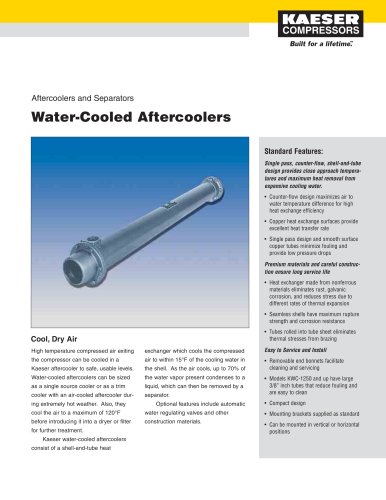
Catalog excerpts

Preview Only. To download entire whitepaper, visit www.kaeser.com/whitepapers. ENERGY EFFICIENT SYSTEM DESIGN FOR WASTEWATER TREATMENT PLANTS: A System Splitting Approach Stephen Horne, Product Manager, Blowers—USA Kaeser Compressors, Inc. Abstract Energy is the single highest operating cost in a wastewater treatment plant. More specifically, the energy to operate blowers for aeration is the single highest energy consumer. Fortunately, blowers and blower systems are becoming more energy efficient as system engineers pay more attention to this critical cost factor. It is no longer enough to only consider the individual equipment’s efficiency. With energy costs on the rise, it is now more important than ever to carefully examine the entire system’s efficiency and understand how each piece of equipment works with one another and how this interaction impacts the overall plant energy efficiency. This paper will outline the traditional approach to wastewater treatment plant design, the efficiency problems associated with this approach, and explain system splitting, an alternate design approach with key efficiency gains. The paper will include guidance on how to calculate specific power for an individual unit as well as an entire system and provide calculation examples for comparing system specific power between traditional and system splitting design approaches. Nature of WWTP Planning Unlike commercial systems, municipal wastewater treatment plants are often designed and built based on projected populations and demand 10, 20, and even 30 years in the future. Because FIGURE 1: OF ALL THE ENERGY COSTS AT A WASTEWATER TREATMENT PLANT, ENERGY FOR AERATION IS BY FAR THE HIGHEST. project funding is available now and may not be available later on, system engineers are tasked with building a system that will continue to serve the community’s growing needs, and in the most cost-effective, energy-efficient way possible. This is no simple task. Although the volume of air needed changes seasonally, day to day, even hour to hour, the general practice is to design the plant’s capacity for the worst case/maximum load. This results in oversizing the blowers. Because the blowers are oversized, they do not operate at their most efficient design point, spending as much as 90% of their operating time wasting costly energy. Kaeser Compressors, Inc. 877-586-2691 www.kaeser.com
Open the catalog to page 1All Kaeser Compressors catalogs and technical brochures
-
Compressed Air Filters
8 Pages
-
Automatic Magnetic Drain
2 Pages
-
Air Treatment Solutions
12 Pages
-
Activated Carbon Tower
2 Pages
-
SmartPipe+TM
28 Pages
-
S Series
8 Pages
-
SX - HSD Series
20 Pages
-
ASD, BSD, and CSD Series
12 Pages
-
KRYOSEC SERIES
4 Pages
-
Portable Compressors
8 Pages
-
Screw Compressor
20 Pages
-
Air Treatment Brochure
12 Pages
-
USGLANCE
6 Pages
-
Mobilair ? M350
2 Pages
-
CLEAN AIR
12 Pages
-
Mobilair M250
2 Pages
-
MobilairM27
2 Pages
-
SigmaControl2
6 Pages
-
Mobilair M122
2 Pages
-
Mobilair M100
2 Pages
-
Mobilair M64
2 Pages
-
Mobilair M57 Utility
2 Pages
-
Mobilair M57
2 Pages
-
Mobilair M50
2 Pages
-
Mobilair M15/M17
2 Pages
-
Mobilair Brochure
6 Pages
-
Hybritec Combination Dryer
8 Pages
Archived catalogs
-
Rotary Screw Vacuum Packages
4 Pages
-
Mobilair Tools
4 Pages
-
Mobilair M270
2 Pages
-
Mobilair M200
2 Pages
-
Mobilair M26
2 Pages
-
Booster Compressors
6 Pages
-
Airbox and Airbox Center
4 Pages
-
Water-cooled Aftercoolers
2 Pages
-
Air Cooled Aftercoolers
4 Pages
-
Air Main Charging System
4 Pages
-
Condensate Filters
4 Pages
-
Eco-Drain Traps
2 Pages
-
Automatic Magnetic Drain
2 Pages
-
High Temperature Afterfilter
2 Pages
-
Oil Mist Eliminator
2 Pages
-
Compressed Air Filters
8 Pages
-
Activated Carbon Tower
2 Pages
-
Membrane Dryers
2 Pages
-
Breathing Air Systems
4 Pages
-
Desiccant Air Dryers
12 Pages
-
Clean Air Treatment Brochure
4 Pages
-
SmartPipe Modular Piping Catalog
72 Pages
-
SmartPipe Modular Piping
72 Pages
-
HSD Series Compressors
8 Pages
-
ESD and FSD Compressors
6 Pages
-
DSD Series Compressors
6 Pages
-
CSD Series Compressors
6 Pages
-
BSD Series Compressors
6 Pages
-
ASD Series Compressors
6 Pages
-
AS Series Compressors
6 Pages
-
SK Series Compressors
6 Pages
-
SM Series Compressors
6 Pages
-
SX Series Compressors
6 Pages
-
AirCenter
4 Pages
































































































